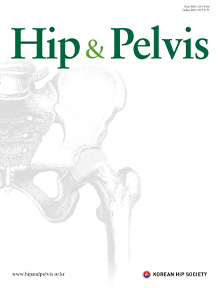Quick links
Related article in
-
Review ArticleSeptember 30, 2014
 0
0
 166
166
 33
33

Medical Treatment of Ankylosing Spondylitis
Kyoung-Ho Moon, MD, PhD, Young-Tae Kim, MD
Hip Pelvis 2014; 26(3): 129-135AbstractThe diagnosis of ankylosing spondylitis is often delayed due to ambiguous clinical manifestations and strict diagnostic criteria. However, imaging techniques such as magnetic resonance imaging have been found effective for the early diagnosis of non-radiographic sacroiliitis. New tumor necrosis factor alpha (TNF-α) inhibitors have good efficacy for patients with persistently high disease activity despite conventional nonsteroidal anti-inflammatory drug treatment. Thus, early diagnosis and aggressive treatments are essential for ankylosing spondylitis patients. Because many patients complain of musculoskeletal pains, especially around the sacroiliac joint area, hip specialists should be informed of up-to-date knowledge. In this review, we discuss new diagnostic criteria for ankylosing spondylitis, administration methods of TNF-αinhibitors, and the long-term follow-up results for patients treated with TNF-αinhibitors. -
Original ArticleSeptember 30, 2018
 0
0
 76
76
 15
15

Long-term Outcomes of Cemented Total Hip Arthroplasty in Patients with Ankylosing Spondylitis at a Minimum Follow-up of 10 Years
Soo Jae Yim, MD, PhD, Yong Bok Park, MD, Junyoung Kim, MD, Sin Hyung Park, MD, PhD
Hip Pelvis 2018; 30(3): 175-181 AbstractPurpose: This study was performed to evaluate long-term clinical and radiologic outcomes of cemented total hip arthroplasty in patients with ankylosing spondylitis.
AbstractPurpose: This study was performed to evaluate long-term clinical and radiologic outcomes of cemented total hip arthroplasty in patients with ankylosing spondylitis.
Materials and Methods: A retrospective study of 12 patients (16 cases) diagnosed with ankylosing spondylitis undergoing total hip arthroplasty with cemented femoral stem from November 2002 to January 2006 with a minimum follow up of 10 years. Clinical outcomes were assessed using Harris Hip Scores and measures of pain and range of motion. Radiologic outcomes were assessed with serial plain X-ray. Fixation and stability of implant, enthesopathy of ischium and development of heterotopic ossification were also evaluated.
Results: Mean Harris Hip Scores significantly improved from pre-operative levels (58 points; range, 39-81 points) to post-operative (92 points; range, 68-100 points). Mean flexion contracture levels decreased from pre-operative (13°) to post-operative (5°), and mean post-operative range of motion improved 106°compared to pre-operative levels. No newly developed osteolysis lesions or implant loosening were observed in last follow up X-rays. One heterotopic ossification and one greater trochanter fracture were observed. Greater trochanter fracture was treated conservatively, and was resulted in bony union. No patients underwent revisions.
Conclusion: This study revealed positive long-term clinical and radiologic outcomes following total hip arthroplasty with cemented femoral stems in patients with ankylosing spondylitis patients.
- 1

Vol.36 No.1
Mar 01, 2024, pp. 1~75
Most Keyword
?
What is Most Keyword?
- It is most registrated keyword in articles at this journal during for 2 years.
Most View
-
Pathophysiology and Treatment of Gout Arthritis; including Gout Arthritis of Hip Joint: A Literature Review
Yonghan Cha, MD
Hip Pelvis 2024; 36(1): 1-11 , Jongwon Lee, MD
, Jongwon Lee, MD  , Wonsik Choy, MD
, Wonsik Choy, MD  , Jae Sun Lee, PhD*,†
, Jae Sun Lee, PhD*,†  , Hyun Hee Lee, MD‡
, Hyun Hee Lee, MD‡  , Dong-Sik Chae, MD‡
, Dong-Sik Chae, MD‡ 
-
Treatment of Osteoporosis after Hip Fracture: Survey of the Korean Hip Society
Jung-Wee Park, MD
Hip Pelvis 2024; 36(1): 62-69 , Je-Hyun Yoo, MD*
, Je-Hyun Yoo, MD*  , Young-Kyun Lee, MD
, Young-Kyun Lee, MD  , Jong-Seok Park, MD†
, Jong-Seok Park, MD†  , Ye-Yeon Won, MD‡
, Ye-Yeon Won, MD‡ 
Editorial Office
Laboratory tests performed in hip fracture patients. CTX: carboxy-terminal telopeptide of collagen I, PTH: parathyroid hormone, P1NP: procollagen type I N propeptide, U/A: urinalysis.|@|~(^,^)~|@|First-line treatment option for osteoporosis in hip fracture patients. BP: bisphosphonate, PTH: parathyroid hormone, SERM: selective estrogen receptor modulator.|@|~(^,^)~|@|Osteoporosis medication in patients with rebound phenomenon after cessation of denosumab. Ca+Vit. D: calcium and vitamin D, PTH: parathyroid hormone, SERM: selective estrogen receptor modulator.|@|~(^,^)~|@|The most important recognized factor for atypical femoral fracture.|@|~(^,^)~|@|Preferred osteoporosis medications after cessation of bisphosphonate in patients with atypical femoral fracture. PTH: parathyroid hormone, Ca+Vit. D: calcium and vitamin D, SERM: selective estrogen receptor modulator.|@|~(^,^)~|@|Preferred osteoporosis medications in patients with high-risk of atypical femoral fracture. Ca+Vit. D: calcium and vitamin D, SERM: selective estrogen receptor modulator, PTH: parathyroid hormone.
Hip Pelvis 2024;36:62~69 https://doi.org/10.5371/hp.2024.36.1.62
© H&P
© 2024. The Korean Hip Society. Powered by INFOrang Co., Ltd




 Cite
Cite PDF
PDF



